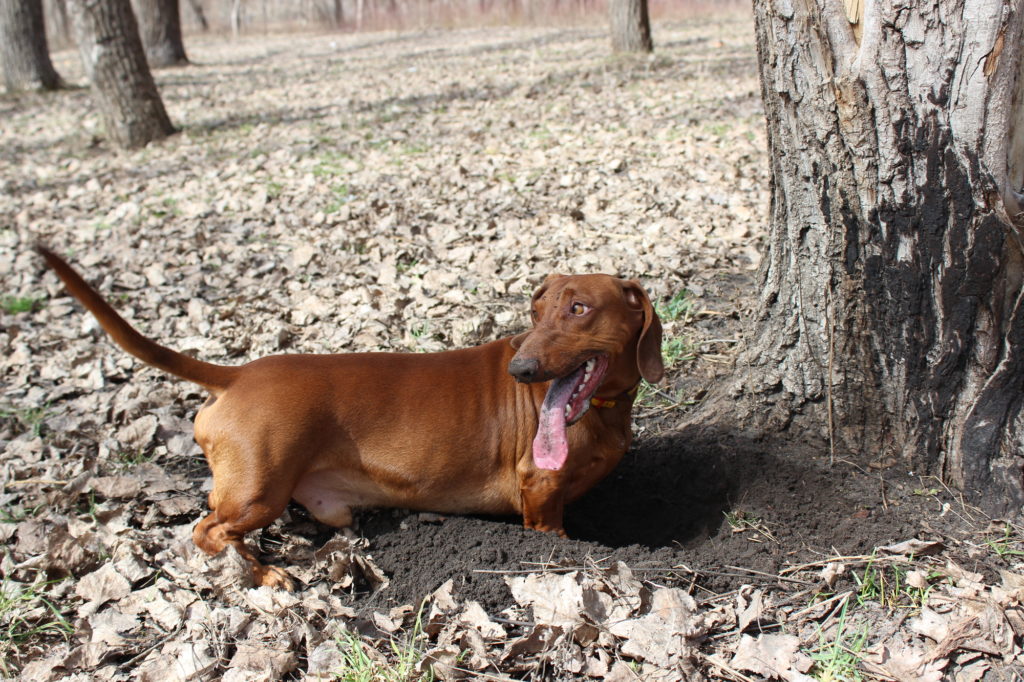Movies, books, TV shows, and other movies often depict dogs burying and digging up bones. Hunting dogs are most commonly associated with the trait, as they were often trained to bury prey to lead their owners to them, but other dog breeds can exhibit the digging behavior as well.
Here are the most common dog breeds that bury bones!
1. Beagles
Beagles are an immensely popular medium dog breed, well-known for being great family dogs and having happy-go-lucky personalities.
They’re good escape artists, too, often giving their owners the run-around when it comes to keeping them contained.
The curious, intelligent, friendly breed has an origin shrouded in mystery. What we do know about its history is that beagles were bred as scent-hounds, following their noses to aid in the detection of various forms of small prey, particularly rabbits.
Despite being easy-going dogs, beagles are also led by their history of hunting to bury resources for safekeeping. This is why beagles tend to enjoy digging up your yard to put treats and bones in – it’s just instinct!
These dogs also have high energy levels and mental stimulation needs.
When these needs aren’t met, beagles may opt to create their own entertainment in a way that is familiar to their instincts, and burying bones and toys is a convenient option.
2. Basset Hounds
The very charming Basset hound is an adorable medium-sized dog, known for its endearing appearance and cutely stubborn personality.
With a lot of stamina and strength, this dog is clearly a breed built for endurance and stamina, with all the strength of a big dog and all the power of its rather large paws.
Basset hounds are a short-legged hound breed known for their patience, a valuable personality trait in their original purpose.
They were bred as scent-hounds and can come second to bloodhounds when it comes to tracking scents and smells on the ground. For the most part, they were used to hunt hare.
This is why Basset hounds tend to enjoy burying bones. They are naturally equipped to hunt down prey and have the instinct to store them for later, either for themselves or for a handler or owner.
Their unparalleled sense of smell means they’re able to easily relocate items they bury, too.
3. Dachshunds
Dachshunds are a rather iconic breed, often called “sausage dogs” due to the long, low shape of their bodies.
These curious, bold, and friendly dogs come in many fur varieties and sizes, and despite their little legs, they have a good deal of energy in their small frames!
Like beagles, Dachshunds are a scent-hound breed, and they specifically seek out prey in the form of burrow-dwelling animals. Standard-sized breeds would flush badgers out of their homes, while miniature breeds sought out rabbits instead.

This history spent digging up badgers is part of what contributes to a Dachshund’s tendency to bury bones, acting as a supplement for the natural resource-saving instinct of a hunting breed.
Dachshunds are also notoriously stubborn, with larger-than-life, spunky personalities that mean they love disobeying orders and making independent decisions.
This means that, even if you’ve tried to deter a Dachshund from burying bones in your garden, the dog is likely to continue its behavior with redoubled effort!
4. Miniature Schnauzers
Contrary to its name, the Miniature Schnauzer is a medium-sized dog that just happens to be the smallest Schnauzer specimen.
With wiry coats, a friendly personality, and evocative facial features, these dogs are brave but not aggressive and are highly trainable with good intelligence.
Miniature Schnauzers were bred down from the standard-size Schnauzer to serve as farm dogs, where they would often become excellent ratters perfect for pest control. Their tough, muscular forms allowed them to tirelessly prowl farms and take down rats with ease.
This is why, despite not being a hunting breed specifically, they continue to bury bones now! They still hunt, just in a more domestic setting, and often needed to burrow a little to get to their prey.
They could then bury their prey for later, as their owners did not need them to bring home prey like hunting dogs.
5. Border Collies
The affectionate, smart, and incredibly energetic border collie is an extremely good worker, bred for herding. These dogs are known for their high intelligence, which contributes to their “herding eye” that is so useful in maintaining their work.
Why, then, do border collies exhibit burying tendencies when they aren’t hunters?
This is because of the stimulation demands of such an intensely high-energy breed. Easily bored, border collies take to creating their own forms of entertainment, often burying their bones, treats, and objects of attention so they can spend time looking later.
They may also simply take out unused energy on soil and furniture, digging as much as they can and then just deciding to bury something since they’ve already dug!
It’s interesting to note that there is a notable divide between border collies bred for show and for work. Show dogs are less likely to exhibit the instinctual traits that make them good workers and, therefore, buriers.
On the other hand, border collies bred for their performance will typically exhibit stronger herding and burying behaviors.
6. Cairn Terriers
Cairn Terriers are highly alert, busy dogs that are recognized as one of the earliest working dog breeds in Scotland.
The cheerful, always-curious dogs are relatively small in size, with intelligence visible in their eyes and a reputation for being extremely loyal companions and boasting a sturdy build.
It is in a Cairn Terrier’s absolute base instinct to dig, bury, and burrow. This is because they were bred as hunting earthdogs.
While they did chase quarry for a long time across the Scottish highlands’ cairns, they were exceptionally good at rooting out burrowing animals. They would simply burrow into the ground to push out any small prey for their owners and handlers.
It makes obvious sense, then, why Cairn Terriers are so prone to burying bones, treats, toys, and other random finds. In fact, proper care and enrichment of a Cairn Terrier usually mean giving them a spot where they can dig and explore to their heart’s content.
Burying behavior will be near-impossible to curb in this breed, so leaning into it is recommended.
7. Bedlington Terriers
Another Terrier on the list, Bedlington Terriers are truly unique dogs. They closely resemble lambs, with fleecy, white fur and a pear-shaped head accompanied by drooping ears and a crisp, curled coat.
A contradictory working dog, it is capable of performing excellently in multiple conditions, including in snowy terrain and on water.
Bedlington Terriers were bred as hunting dogs, with sharp attitudes, quick speeds on land and water, great endurance, and a love for frolicking. Their tendency to bury bones can, like many other dogs’, be linked to their hunting instincts, burying captured quarry to lead their owners to.
Bedlington Terriers are highly versatile, able to adapt to tons of scenarios, and be happy in many different conditions.
This means that you can likely train out burying tendencies without affecting the dog’s happiness and enrichment by providing better alternatives. However, there’s no harm in giving the dog a safe place to dig anyway!
8. Alaskan Malamutes
The affectionate and loyal Alaskan Malamute is the absolute epitome of a heavy-duty working dog.
With a strong, substantial, and sturdy body, dense weatherproof coat, and powerful muscles with a deep chest, these dogs don’t necessarily need to work for their temperaments but do enjoy a good job and are capable of a lot of hard labor.
The large breed of the Alaskan Malamute was originally bred as a hound and sledding dog. Their primary purpose was to haul large and heavy items and freight, though they could also be used for short-distance hunting and quick prey capture and hauling.
This is what lends itself to the burying instinct of these dogs, as they have a high prey drive and are naturally attuned to the desire to save prey, and therefore food and treats, for later.
Today, you often see Alaskan Malamutes used for sled-racing, which is why it can be so surprising to see them exhibiting hunting dog behaviors. But their old instincts remain despite their modern uses!
9. Siberian Huskies
Siberian Huskies are medium-sized working dogs with mischievous personalities and a tendency for noise and vocalization.
They’re long-distance workers, gracefully working in packs to pull loads across frozen tundras with remarkable endurance. Their muscular build is a delightful contrast to their nimbleness, and their loyalty is well-known.
Why, then, do Siberian Huskies like to bury bones? To understand this, we have to go far back in time. The breed originates in Eastern Siberia, where it was bred by the Chukchi people.
The Chukchi people allowed the dogs to freely roam in the summer months, as they were only needed during winter to haul items across long distances. In the summer, the dogs remained in their packs and hunted for themselves, not returning to their owners until snow fell and food was harder to come by.
Siberian Huskies now retain a lot of those instincts and have a very high prey drive when it comes to small animals. They even have to be trained to be trusted around smaller pets.
Saving food for later by burying it would have been an important part of survival in the wild for these dogs, which is why they continue to bury bones now.
Conclusion
Most dogs who bury bones do so because they were meant to hunt small game.
They would run ahead of their handlers in search of a quarry, then successfully dispatch and kill the prey before burying them. With prey safely buried, they would run back to their owners and lead them to the captured quarry.
Other breeds may have other reasons to bury bones, such as survival instincts from needing to hunt for their own food and save it. Regardless, this behavior is purely instinctual and these dogs will benefit from being allowed to bury items in certain areas!

